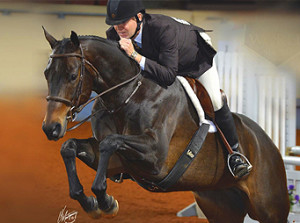Chuck Briggs – Choosing and Starting an Over Fence Prospect
Click here to read the complete article82 – November/December, 2017
By Rachel Kooiker
 Over fence classes grew out of the Fox Hunting tradition. Once upon a time, fox hunters were bred to clear natural-looking obstacles, travel with an efficient and smooth gait, and remain impeccably well-mannered during the chaos of the hunt. Now, when you look at the hunter ring at a breed show, you should expect to see a well-turned out horse and rider making a striking picture as they float around a course, jumping obstacles fluidly without so much as the flick of an ear to marr the relaxed, pleasant expression. But how do you go about transitioning a young horse from rail to course? Read on as multiple Congress and World Champion Chuck Briggs of Turning Point Ranch shares insights from his nearly 30-year career of selecting, developing, and maintaining toplevel hunter mounts.
Over fence classes grew out of the Fox Hunting tradition. Once upon a time, fox hunters were bred to clear natural-looking obstacles, travel with an efficient and smooth gait, and remain impeccably well-mannered during the chaos of the hunt. Now, when you look at the hunter ring at a breed show, you should expect to see a well-turned out horse and rider making a striking picture as they float around a course, jumping obstacles fluidly without so much as the flick of an ear to marr the relaxed, pleasant expression. But how do you go about transitioning a young horse from rail to course? Read on as multiple Congress and World Champion Chuck Briggs of Turning Point Ranch shares insights from his nearly 30-year career of selecting, developing, and maintaining toplevel hunter mounts.
THE WOW FACTOR
“I have a steadfast plan when I pick my hunters, and it works every time,” Briggs says. ‘I don’t buy a horse to be a working hunter; I buy my horses to be under saddle horses. I like my hunters to move well. When a horse canters into the ring, I want everyone to be thinking –
Wow!” It helps if you think about over fence classes as flat work with obstacles. You shouldn’t take a horse that doesn’t excel on the rail and expect to turn it into a working hunter winner. Show hunters are judged on movement, jumping ability, fluidity, and temperament. The ideal hunter moves with flat knees, meaning their front legs float across the ground. Think of a horse that could cut daisies with each stride. In fact, ‘daisy cutter’ is a slightly out of date term used to describe this ideal way of going: flat at the knee with good hocks underneath them as they travel. Briggs has a keenly developed eye for the type of movement he likes in a hunter prospect, but he does test them a bit by longing the horse over a small jump to gauge the animal’s natural ability, instinct, and reaction to jumping. He explains, “When you’re looking for a hunter, you need to have talent and instinct. If they don’t have some natural instinct to jump, I don’t waste my time.”
82 – November/December, 2017










